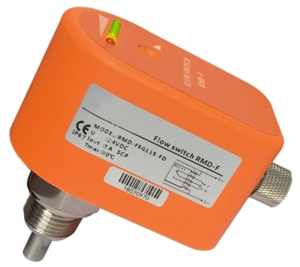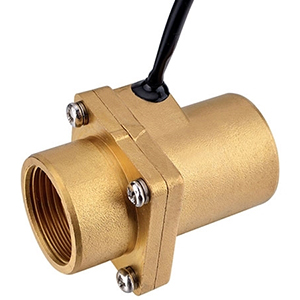Flow Switch Working Principle
The flow switch is mainly installed on-line or plug-in in medium pipelines such as water, gas and oil to monitor the flow of water in the water system. When the water flow is higher or lower than a certain set point, the output alarm signal of the flow switch is triggered and transmitted to the unit, and the system can make corresponding indication actions after obtaining the signal.
Thermal Dispersion Flow Switch Working Principle
 Thermal dispersion flow switches are designed according to the principle of heat exchange. The probe has built-in a heating module and a temperature sensing module. The thermal conduction of thermal flow switches is closely related to the flow rate of the medium. During the measurement, heat is generated by the heating module. If there is no medium flowing in the pipe, the heat received by the thermal sensing module is a fixed value. When there is a medium flowing, the heat received by the thermal sensor module will change with the change of the medium flow rate. The thermal sensor module converts the temperature difference signal into an electrical signal, and then converts it into a corresponding standard analog signal or contact through the processor signal is output. The thermal dispersion flow switch displays and controls the flow of the medium through this signal.
Thermal dispersion flow switches are designed according to the principle of heat exchange. The probe has built-in a heating module and a temperature sensing module. The thermal conduction of thermal flow switches is closely related to the flow rate of the medium. During the measurement, heat is generated by the heating module. If there is no medium flowing in the pipe, the heat received by the thermal sensing module is a fixed value. When there is a medium flowing, the heat received by the thermal sensor module will change with the change of the medium flow rate. The thermal sensor module converts the temperature difference signal into an electrical signal, and then converts it into a corresponding standard analog signal or contact through the processor signal is output. The thermal dispersion flow switch displays and controls the flow of the medium through this signal.
Thermal dispersion technology is a technology with excellent performance and high reliability under harsh conditions. The typical working principle is that when two sensing elements are placed in a fluid, one of them is heated and the other is used to sense the process temperature. The temperature difference between the two sensing elements is related to the process flow rate and the properties of the process medium. The temperature difference between the two sensing elements is greatest at no flow, but as the flow increases, the heated sensing element cools and the temperature difference decreases. The fluid flow rate directly affects the degree of thermal diffusion.
Thermal air water flow switch consists of two temperature sensors, power supply, signal processor and output relay or NPN/PNP transistor output. This type of temperature sensor is manufactured using special semiconductors. The physical characteristics of the two sensors are very close, and they are separated from each other by a certain distance, and the thermal influence on each other is negligible. The sensor pair tracks the temperature of the medium. The voltage drop of these sensors is proportional to temperature and operates accurately over a wide temperature range. Heat one of the sensors above the medium temperature. The other sensor has the same temperature as the medium. Equal constant current flows through the two sensors to produce a voltage difference that is inversely proportional to the amount of heat absorbed by the medium on the first sensor. Since the flow rate of the medium is proportional to the heat taken away, by measuring the voltage difference between the two sensors, the flow rate of the medium at this time can be known, and the flow rate of the medium can be known by calculation.
Water Flow Switch Working principle

When there is water flowing in the water flow switch, and the water flow rate is greater than or equal to 1.0 liters per minute, the magnetic core in the water flow switch is displaced by the water flow, and the displacement of the magnetic core drives the magnetic source to produce a magnetic control effect, so that the water flow switch outputs "on" signal. The automatic selection of the flow switch is included in the quick and easy selection. The signal is input to the equipment control system, and the control system realizes the control function. When the water flow is less than the starting flow, the water flow switch outputs an "off" signal. The control system produces the opposite control action to the above. In other words: water flow switch When the flow rate of water in the pipeline is greater than 1 liter per minute, the magnetic core will be displaced under the action of the water flow and drive the magnetic source to produce a magnetic control effect, so that the sensor outputs a "1" switch signal, which is input To the equipment control system, the purpose of water flow control is realized after power expansion. When the water flow in the pipeline is less than 1 liter per minute, the magnetic core drives the magnetic source to return under the thrust of the return spring, so that the sensor outputs a "0" switch signal and stops the system. The flow switch has the advantages of high sensitivity and strong durability.
ATO thermal dispersion flow switches can measure flow velocity of different media, including air, oil, water and other liquids. Moreover, low price G1/4", G1/2" and G3/4" magnetic water flow switches are offered for different types of water systems, buy now!

